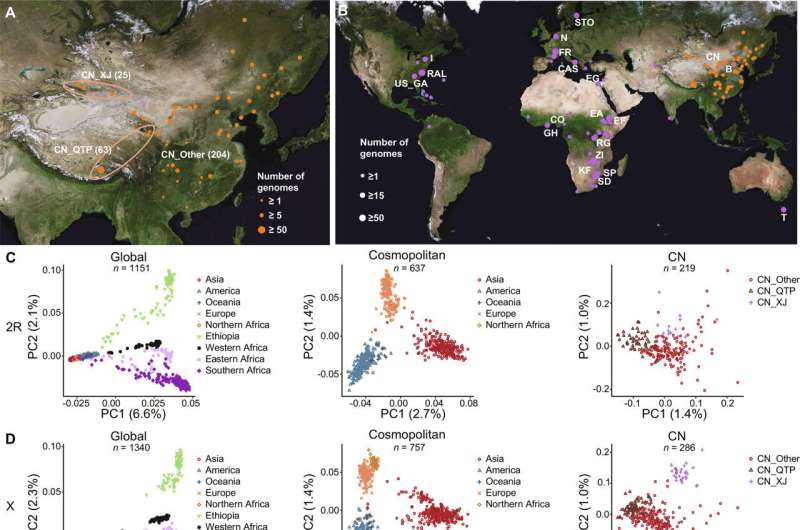This article has been reviewed according to Science X's editorial process and policies. Editors have highlighted the following attributes while ensuring the content's credibility:
fact-checked
peer-reviewed publication
trusted source
proofread
Chinese fruit fly genomes reveal global migrations, repeated evolution

Fruit flies (Drosophila melanogaster), which humans have inadvertently spread around the globe, arrived in China roughly 4,000 years ago, according to a new population genomics study that adds to our understanding of the insect's global migration, demography, gene flow and adaptations.
The researchers found that Chinese fruit-fly populations have been genetically isolated, with that isolation reflecting China's ancient culture and relatively closed society with limited trade with Asia and Europe for many centuries. This isolation also allowed the authors to see if similar evolutionary pressures resulted in similar genetic changes, a test of the repeatability of evolution.
"The amazing story about Drosophila melanogaster is their genetic differences among populations mirror how humans spread, from an origin in Africa, followed by migration out of Africa, but it's much more recent," said Andrew Clark, the Jacob Gould Schurman Professor of Population Genetics in the College of Arts and Sciences. Clark is co-corresponding author of the study published April 17 in the journal Science Advances. Jian Lu, a professor of evolutionary biology at Peking University, China, and a former postdoctoral researcher in Clark's lab, is the other corresponding author.
The authors combined their own results with those of previous studies and propose that D. melanogaster originated in southern Africa and migrated out of northern Africa around 9,000 years ago. From there, the flies expanded into East Asia and China (~2.8-4.4 thousand years ago), to Europe (~1.8 thousand years ago), and most recently to North America (only ~150 years ago) and Australia (~100 years ago).
The flies are a human commensal—an organism that benefits from an association with another organism that derives neither benefit nor harm. They thrive on rotting fruit in orchards and vineyards.
"Humans were making the trek out of Africa on the order of 80,000 years ago or so, but agricultural production of fruit began less than 10,000 years ago," Clark said. "It's really modern human trade that helped disperse flies across the globe."
In the study, the researchers sequenced the genomes of 292 D. melanogaster strains from various settings in China and analyzed them along with previously published genome sequences. They found the strains from China represented a unique ancestry group, with noticeable differentiation among subpopulations within China. The paper clarified the extent and duration of isolation of the Chinese populations, a result that had only been hinted at in earlier studies.
The global population genomic data allowed the researchers to develop a computer model to estimate the times when D. melanogaster arrived on each continent, and infer how genetic changes, which cluster together in the genomes of closely related strains, correspond with geographic movements.
D. melanogaster is a model organism used widely by researchers to study fundamental processes of development and gene regulation, as well as the genetic basis of environmental adaptation. In the study, Clark, Lu, and colleagues identified genetic changes in response to insecticides.
"When humans apply insecticides, it puts terrific pressure on a population, and many insects develop resistance relatively quickly," Clark said. These changes are often genetically fairly simple, Clark said, involving just a few genes that have a large effect, as opposed to complex traits that may involve hundreds of genes.
The adaptations that occurred in the Chinese populations were independent of other geographic populations, and occurred as unique mutations in the same genes found in other populations that have developed insecticide resistance. "It is a nice example of a natural repeated trial of evolution with basically the same outcome," Clark said.
More information: Junhao Chen et al, From sub-Saharan Africa to China: Evolutionary history and adaptation of Drosophila melanogaster revealed by population genomics, Science Advances (2024). DOI: 10.1126/sciadv.adh3425
Journal information: Science Advances
Provided by Cornell University




















